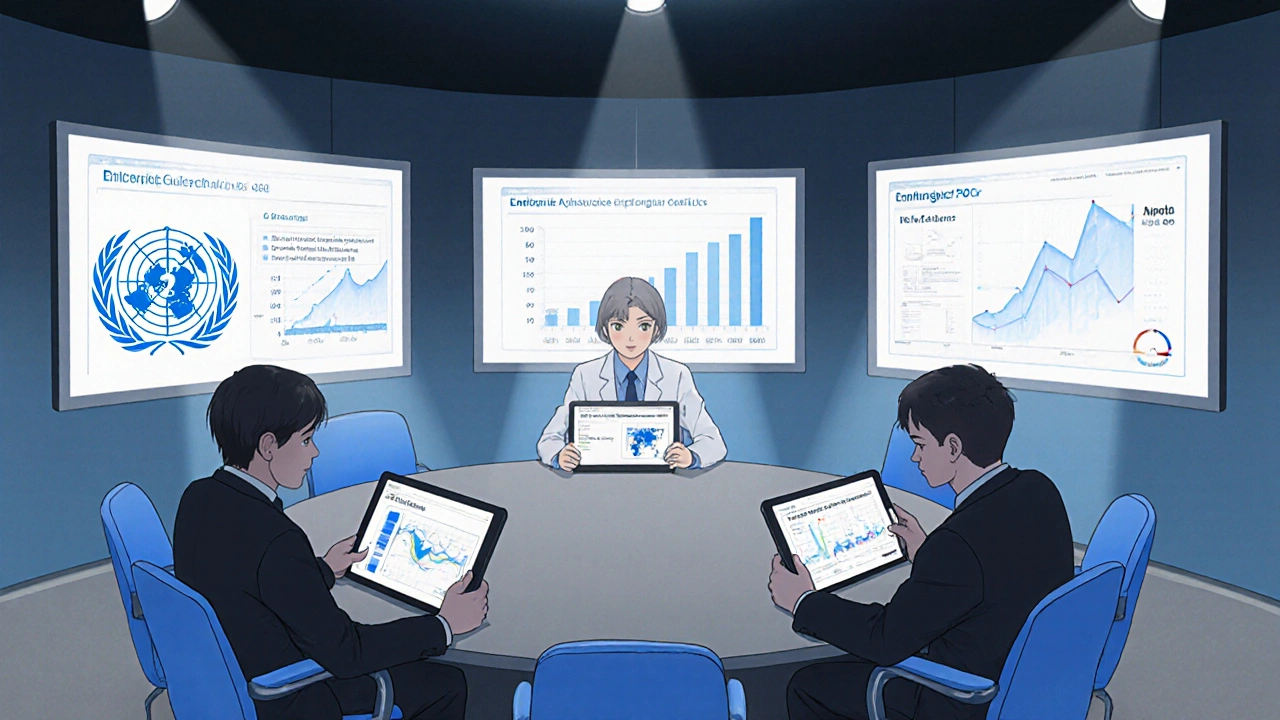Key Takeaways
- The efavirenz‑emtricitabine‑tenofovir triple (often branded as Atripla) became the first once‑daily, single‑tablet regimen recommended by major health agencies.
- WHO’s 2023 and 2025 guidelines still list the combination as an alternative first‑line option, especially where newer integrase inhibitors are unavailable.
- CDC and European AIDS Clinical Society (EACS) moved towards integrase‑based regimens after 2022, but keep efavirenz‑based therapy on the list for patients with contraindications to newer drugs.
- Real‑world data show high viral suppression rates (>85%) with the regimen, but neuro‑psychiatric side effects and resistance mutations remain concerns.
- Emerging long‑acting formulations and tenofovir alafenamide (TAF) are gradually displacing the original triple in high‑income settings.
What Is Efavirenz‑Emtricitabine‑Tenofovir?
When building antiretroviral therapy (ART) for HIV‑1, Efavirenz‑Emtricitabine‑Tenofovir is a fixed‑dose combination that packs three drugs into one pill taken once daily. Efavirenz is a non‑nucleoside reverse transcriptase inhibitor (NNRTI), emtricitabine a nucleoside reverse transcriptase inhibitor (NRTI), and tenofovir disoproxil fumarate (TDF) another NRTI. The trio targets reverse transcription at two points, creating a potent barrier to viral replication.
Why the Combination Became a Game‑Changer
Before 2006, patients often juggled two or three separate pills, leading to missed doses and higher resistance risk. The single‑tablet format simplified adherence, lowered pharmacy costs, and provided a clear signal that ART could be both effective and tolerable. Clinical trials (e.g., the ACTG 5142 study) showed >90% suppression at 48 weeks, prompting agencies to consider it for first‑line use.
Evolution of Global HIV Treatment Guidelines
Guideline committees update recommendations based on efficacy, safety, cost, and drug availability. The World Health Organization (WHO), United States Centers for Disease Control and Prevention (CDC), and European AIDS Clinical Society (EACS) each publish updates on a 1‑2‑year cycle.
WHO Recommendations
In the 2016 WHO guideline, efavirenz‑based regimens were the sole preferred first‑line option. By 2023, WHO introduced integrase strand transfer inhibitors (INSTIs) like dolutegravir as the preferred choice, relegating efavirenz‑emtricitabine‑tenofovir to an “alternative” category for patients where dolutegravir is contraindicated (e.g., pregnancy in early 2022). The 2025 update kept this stance, emphasizing a phased switch to dolutegravir while acknowledging supply‑chain gaps in low‑resource settings.
CDC Guidance
CDC’s 2021 guideline elevated dolutegravir‑based regimens as first line, but retained efavirenz‑emtricitabine‑tenofovir as a “recommended alternative” for patients with neuro‑psychiatric tolerance or when INSTIs are not covered by insurance. The 2024 revision added a note about tenofovir alafenamide (TAF) reducing renal toxicity, yet still listed the original triple for patients with stable kidney function.
EACS Position
EACS mirrored CDC’s shift, recommending bictegravir or dolutegravir plus emtricitabine‑TAF as the go‑to regimen. Efavirenz‑emtricitabine‑tenofovir remained on the table for individuals with established NNRTI‑sensitive virus and no severe psychiatric history.

Impact on Patient Outcomes
Large cohort studies in sub‑Saharan Africa (e.g., the TREAT‑Asia and IeDEA collaborations) report viral suppression rates of 80‑88% after 12 months on efavirenz‑emtricitabine‑tenofovir, comparable to INSTI‑based therapy when adherence is high. However, a meta‑analysis of 15 trials highlighted a 12% higher discontinuation rate due to CNS side effects, such as vivid dreams and mood changes.
Safety, Resistance, and Monitoring
Renal toxicity is less common with TDF than with older NRTIs, but the drug still requires baseline eGFR testing. Resistance patterns show the K103N mutation as the most frequent NNRTI‑related change, which can compromise efavirenz effectiveness. Regular viral load monitoring (every 3-6 months) remains essential, especially in settings where resistance testing is scarce.
Comparison of Guideline Recommendations (2025)
| Guideline Body | Preferred Regimen | Alternative Regimen | Key Contra‑indications | Year Updated |
|---|---|---|---|---|
| WHO | Dolutegravir + Emtricitabine + Tenofovir alafenamide (TAF) | Efavirenz + Emtricitabine + Tenofovir disoproxil fumarate (TDF) | Severe psychiatric disease (efavirenz); renal impairment <70 mL/min (TDF) | 2025 |
| CDC | Bictegravir + Emtricitabine + TAF | Efavirenz + Emtricitabine + TDF | Pregnancy (early 2022 for efavirenz); hepatitis B co‑infection (requires tenofovir) | 2024 |
| EACS | Dolutegravir + Emtricitabine + TAF | Efavirenz + Emtricitabine + TDF | Active CNS disease; eGFR <60 mL/min (TDF) | 2024 |

Future Directions and Emerging Alternatives
Long‑acting injectables like cabotegravir‑rilpivirine are making headway in high‑income countries, promising adherence improvements. Meanwhile, tenofovir alafenamide (TAF) is being paired with newer NRTIs to lower bone and kidney toxicity. In low‑resource settings, efavirenz‑emtricitabine‑tenofovir will likely stay on the guideline shelf until cost‑effective INSTIs become widely available.
Practical Checklist for Clinicians
- Confirm baseline renal function (eGFR ≥60 mL/min for TDF).
- Screen for psychiatric history; consider alternative if severe.
- Educate patients about possible CNS side effects and advise reporting within the first month.
- Order viral load at 3‑month intervals; switch if >200 copies/mL on two consecutive tests.
- Document any switches to TAF‑based regimens, noting the reason (e.g., renal toxicity).
Frequently Asked Questions
Is efavirenz‑emtricitabine‑tenofovir still the best first‑line option in 2025?
In most high‑income countries, INSTI‑based combos have taken the lead because they have fewer CNS side effects and a higher barrier to resistance. However, in many low‑ and middle‑income settings where INSTIs are scarce or costly, the efavirenz‑emtricitabine‑tenofovir triple remains a viable, guideline‑approved alternative.
What are the most common side effects patients report?
Vivid dreams, dizziness, and mood changes are the hallmark CNS effects of efavirenz. Renal monitoring is needed for tenofovir disoproxil fumarate, though severe kidney injury is rare.
How does resistance to efavirenz develop?
The K103N mutation is the classic NNRTI resistance pattern. If viral load remains detectable after 12 weeks, resistance testing should be performed before switching to another regimen.
Can pregnant women use this combination?
Early data suggested potential teratogenicity when efavirenz is used in the first trimester, so most guidelines now recommend avoiding it during early pregnancy and opting for dolutegravir‑based regimens instead.
What is the role of tenofovir alafenamide (TAF) compared to tenofovir disoproxil fumarate (TDF)?
TAF delivers the same antiviral potency with 90% lower systemic exposure, reducing bone density loss and kidney strain. Many newer guidelines now prefer TAF when available.


Hi, I'm Caden Lockhart, a pharmaceutical expert with years of experience in the industry. My passion lies in researching and developing new medications, as well as educating others about their proper use and potential side effects. I enjoy writing articles on various diseases, health supplements, and the latest treatment options available. In my free time, I love going on hikes, perusing scientific journals, and capturing the world through my lens. Through my work, I strive to make a positive impact on patients' lives and contribute to the advancement of medical science.